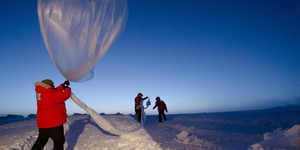Summary
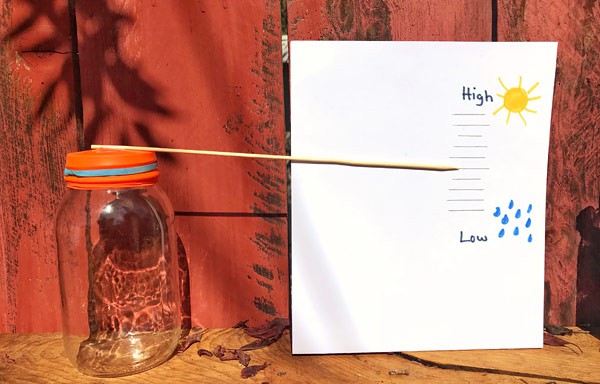
The end of a wooden skewer is attached to a balloon stretched over a glass jar. When air inside the jar expands or contracts the rubber membrane of the balloon will either push out or pull in, moving the free end of wooden skewer up or down. A simple chart of high and low pressure is placed behind the end of the wooden skewer that hangs off the jar so when the balloon moves the skewer will point to high or low pressure readings on the paper.
Introduction
Have you ever seen a weather forecast on TV? If so, you might have noticed the letters "H" and "L" moving around on the weather map. They are often referred to as zones of "high pressure" (H) and "low pressure" (L). The pressure they are talking about is the atmospheric pressure. Changes in air pressure can forecast short-term changes in the weather. But how do you know if the air pressure changes, or if it is high or low? Scientists have developed an instrument called a barometer that can measure atmospheric pressure. In this activity, you will find out how a barometer works by building one yourself!
Materials
- Heat-resistant glass jar
- Rubber band that fits around the mouth of the glass jar
- Balloon
- Wooden skewer
- Scissors
- Tape
- Paper
- Pencil
- Bowls (3)
- Tap water (hot, cold)
- Ice cubes
- Paper towels
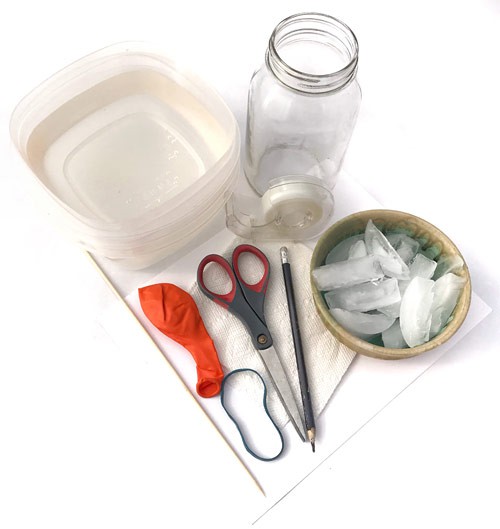 Image Credit: Svenja Lohner, Science Buddies / Science Buddies
Image Credit: Svenja Lohner, Science Buddies / Science Buddies
Prep Work
- Cut off and discard the opening of the balloon, then stretch the remaining balloon piece around the opening of the glass jar, wrapping it tightly.
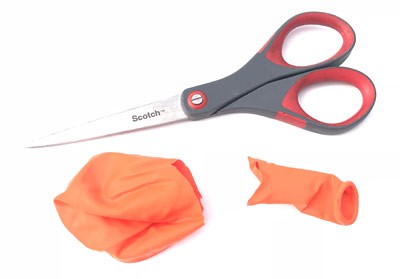 Image Credit: Svenja Lohner, Science Buddies / Science Buddies
Image Credit: Svenja Lohner, Science Buddies / Science Buddies
- Secure the balloon to the jar with the rubber band.
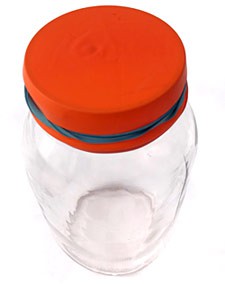 Image Credit: Svenja Lohner, Science Buddies / Science Buddies
Image Credit: Svenja Lohner, Science Buddies / Science Buddies
- Tape the end of the wooden skewer flat onto the top of the balloon with the pointy tip pointing away from the jar.
 Image Credit: Svenja Lohner, Science Buddies / Science Buddies
Image Credit: Svenja Lohner, Science Buddies / Science Buddies
- Fill the first bowl with room temperature water, the second bowl with hot tap water (be careful not to scald yourself!), and the third bowl with ice water.
- Place your barometer close to a wall with the skewer parallel to the wall.
- Tape a piece of paper behind the barometer on the wall.
- Draw a line on the paper that lines up with the tip of the skewer.
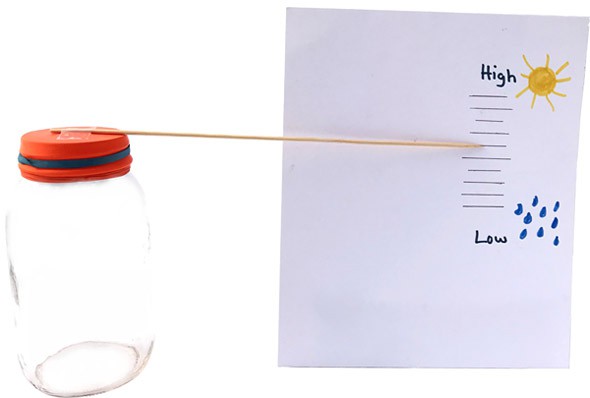 Image Credit: Svenja Lohner, Science Buddies / Science Buddies
Image Credit: Svenja Lohner, Science Buddies / Science Buddies
- Mark the position where the barometer is placed. You will have to place it on the same spot later during the experiment.
Instructions
- Take the barometer and place the glass jar in the bowl with the hot water. The water should not reach beyond the rubber band.
- After one minute, take the barometer out of the water, quickly dry it off, and place it at the same spot close to the wall where you have attached the paper. Make another line on the paper so that it lines up with the pointy tip of the skewer.What do you observe about the barometer? Do you notice any changes? If yes, what kind of changes? Where does the tip point now? How did the barometer change?
- Place the barometer into the bowl with room temperature water. Again, observe what happens. Keep in the bowl for about 10 minutes.
- After 10 minutes, put the barometer back at its spot by the wall and make another line on the paper where the skewer is pointing.How does the barometer look different from before? What do you notice this time?
- Next, place the barometer into the bowl with ice water for about one minute.
- Again, place the barometer in front of your paper chart, and make another line where the skewer tip is pointing.What happens to the barometer in the ice water? What differences do you notice? Can you explain your observations?
- Finally, place the barometer into the bowl with room temperature water and repeat step three and four once more.Where does the skewer tip point to this time? Why?
Cleanup
What Happened?
Were you able to measure the change in air pressure with your barometer? In this experiment, you actually measured the air pressure changes inside the glass jar, not the external atmospheric pressure change. As we cannot change the external atmospheric pressure ourselves, we changed the air pressure inside the glass jar to demonstrate how the balloon barometer works.
When you seal the glass jar with the balloon, there is a certain air pressure inside the glass jar. The tip of the wooden skewer should be pretty level with the top of the glass jar as the balloon surface is very flat. However, when you put the glass jar in the hot water, the air inside the jar heats up and expands. As the jar is sealed with the balloon, it has nowhere to escape—the balloon starts to bulge. This is because the air pressure inside the glass increases and is pressing against the balloon. As a result, the wooden skewer points downwards. The line that you made should be below the original line.
When you put the balloon into room temperature water, the air is cooling back to room temperature where it was before, so your balloon should become flat again. At the same time, the wooden skewer should line up with your original line. The opposite happens when you put the glass jar in ice water. As the air inside the jar cools down even more, it contracts and pulls the balloon into the jar. This makes the wooden skewer point upwards. The line that you made for ice water should be above your original line. Back in room temperature water, the balloon and the wooden skewer should get back to their original positions.
If you measure external air pressure with your barometer, the reverse will happen: the skewer will point upwards with rising atmospheric pressure as the air outside the jar pushes onto the balloon. With falling atmospheric pressure, the wooden skewer will point downwards. Marking the location of the wooden skewer every day can tell you what kind of weather to expect!
Digging Deeper
Earth is surrounded by a layer of air called the atmosphere. The atmosphere is about 300 miles thick, and most of it is within 10 miles of Earth's surface. The air is made up of gas molecules such as nitrogen, oxygen, and carbon dioxide. All of these molecules press down on the Earth, and this pressure is called air, or atmospheric pressure.
You might be surprised to learn that air has a weight, although you don't feel it. You might also wonder why air pressure does not crush us. The simple reason is that we have evolved so that the pressure inside our body matches the external atmospheric pressure. However, you are able to feel changes in atmospheric pressure. For example, if you go up in an airplane, your ears might start to hurt. This is because at high altitude, your internal pressure is greater than the external pressure. Only when you balance both pressures by making your ears "pop" will they stop hurting.
The atmospheric pressure is highest at sea level and decreases when you move up into the atmosphere. At sea level, normal air pressure ranges from 800 to 1050 millibars. On top of Mount Everest, the air pressure is about 30 percent less! Air pressure changes with both altitude and temperature. Warm air, which is less dense, rises and results in lower air pressure. When air rises, it cools and as a result, water vapor in the air condenses into liquid. This leads to cloud formation and rain. "Low pressure," therefore, is generally associated with cloudy and rainy weather. On the other hand, high-density cold air results in increased air pressure. As cold air sinks, it dries, causing warm and dry weather conditions in "high pressure" zones.
Now that we know how air pressure can help predict the weather, we still need to find out how to measure air pressure. To do this, scientists have developed the barometer. Many different types of barometers exist. One of them is the water-based barometer: water is sealed in a glass container with a narrow spout connecting the outside to the inside. When the outside air pressure increases, it pushes onto the water in the spout, resulting in a water level decrease. When less air (lower air pressure) pushes onto the water inside the spout, the water level rises.
Ask an Expert
For Further Exploration
- Repeat your experiment with different water temperatures. How do your results change with other water temperatures?
- Take your barometer outside to measure atmospheric pressure. On another piece of paper, draw a scale that looks like a ruler. Then, place the chart next to the barometer so that the middle line is lining up with the skewer tip. Leave the barometer outside for several days and every day, mark where the skewer is pointing. What does it mean when the tip is moving up or down on your scale?




